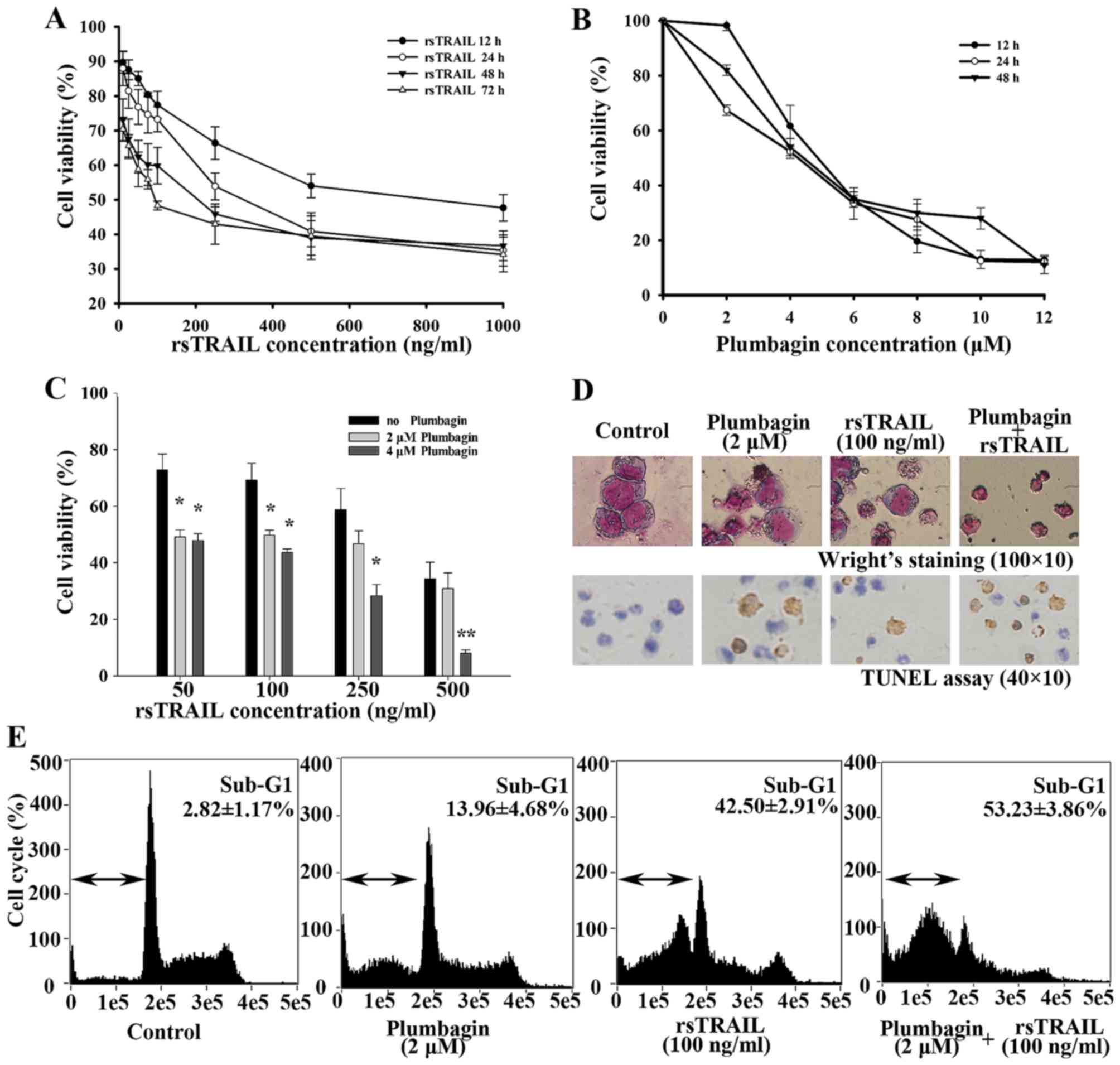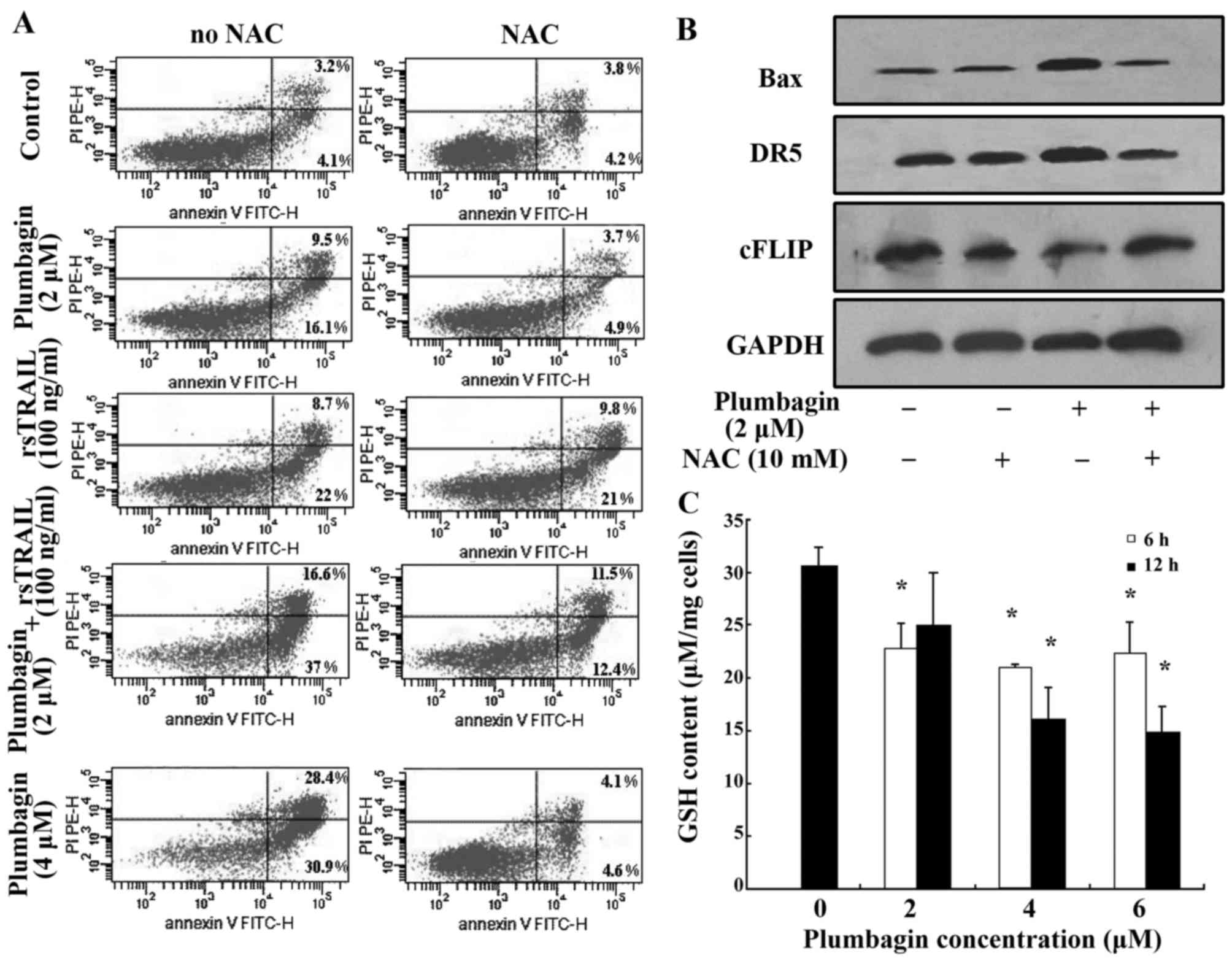|
1
|
LeBlanc HN and Ashkenazi A: Apo2L/TRAIL
and its death and decoy receptors. Cell Death Differ. 10:66–75.
2003. View Article : Google Scholar : PubMed/NCBI
|
|
2
|
Mahalingam D, Szegezdi E, Keane M, de Jong
S and Samali A: TRAIL receptor signalling and modulation: Are we on
the right TRAIL? Cancer Treat Rev. 35:280–288. 2009. View Article : Google Scholar : PubMed/NCBI
|
|
3
|
Sessler T, Healy S, Samali A and Szegezdi
E: Structural determinants of DISC function: New insights into
death receptor-mediated apoptosis signalling. Pharmacol Ther.
140:186–199. 2013. View Article : Google Scholar : PubMed/NCBI
|
|
4
|
Ashkenazi A, Holland P and Eckhardt SG:
Ligand-based targeting of apoptosis in cancer: The potential of
recombinant human apoptosis ligand 2/Tumor necrosis factor-related
apoptosis-inducing ligand (rhApo2L/TRAIL). J Clin Oncol.
26:3621–3630. 2008. View Article : Google Scholar : PubMed/NCBI
|
|
5
|
Ashkenazi A, Pai RC, Fong S, Leung S,
Lawrence DA, Marsters SA, Blackie C, Chang L, McMurtrey AE, Hebert
A, et al: Safety and antitumor activity of recombinant soluble Apo2
ligand. J Clin Invest. 104:155–162. 1999. View Article : Google Scholar : PubMed/NCBI
|
|
6
|
Zhang L and Fang B: Mechanisms of
resistance to TRAIL-induced apoptosis in cancer. Cancer Gene Ther.
12:228–237. 2005. View Article : Google Scholar : PubMed/NCBI
|
|
7
|
Van Geelen CMM, de Vries EGE and de Jong
S: Lessons from TRAIL-resistance mechanisms in colorectal cancer
cells: Paving the road to patient-tailored therapy. Drug Resist
Updat. 7:345–358. 2004. View Article : Google Scholar : PubMed/NCBI
|
|
8
|
O'Kane HF, Watson CJ, Johnston SR, Petak
I, Watson RW and KE; O Kane HF Williamson: Targeting death
receptors in bladder, prostate and renal cancer. J Urol.
175:432–438. 2006. View Article : Google Scholar : PubMed/NCBI
|
|
9
|
Cheng J, Hylander BL, Baer MR, Chen X and
Repasky EA: Multiple mechanisms underlie resistance of leukemia
cells to Apo2 Ligand/TRAIL. Mol Cancer Ther. 5:1844–1853. 2006.
View Article : Google Scholar : PubMed/NCBI
|
|
10
|
Padhye S, Dandawate P, Yusufi M, Ahmad A
and Sarkar FH: Perspectives on medicinal properties of plumbagin
and its analogs. Med Res Rev. 32:1131–1158. 2012. View Article : Google Scholar : PubMed/NCBI
|
|
11
|
Krishnaswamy M and Purushothaman KK:
Plumbagin: A study of its anticancer, antibacterial &
antifungal properties. Indian J Exp Biol. 18:876–877.
1980.PubMed/NCBI
|
|
12
|
Mishra BB, Singh DD, Kishore N, Tiwari VK
and Tripathi V: Antifungal constituents isolated from the seeds of
Aegle marmelos. Phytochemistry. 71:230–234. 2010. View Article : Google Scholar : PubMed/NCBI
|
|
13
|
Abdul KM and Ramchender RP: Modulatory
effect of plumbagin (5-hydroxy-2-methyl-1,4-naphthoquinone) on
macrophage functions in BALB/c mice. I. Potentiation of macrophage
bactericidal activity. Immunopharmacology. 30:231–236. 1995.
View Article : Google Scholar : PubMed/NCBI
|
|
14
|
Pradeepa V, Sathish-Narayanan S,
Kirubakaran SA and Senthil-Nathan S: Antimalarial efficacy of
dynamic compound of plumbagin chemical constituent from Plumbago
zeylanica Linn (Plumbaginaceae) against the malarial vector
Anopheles stephensi Liston (Diptera: Culicidae). Parasitol Res.
113:3105–3109. 2014. View Article : Google Scholar : PubMed/NCBI
|
|
15
|
Checker R, Patwardhan RS, Sharma D, Menon
J, Thoh M, Sandur SK, Sainis KB and Poduval TB: Plumbagin, a
vitamin K3 analogue, abrogates lipopolysaccharide-induced oxidative
stress, inflammation and endotoxic shock via NF-κB suppression.
Inflammation. 37:542–554. 2014. View Article : Google Scholar : PubMed/NCBI
|
|
16
|
Sharma I, Gusain D and Dixit VP:
Hypolipidaemic and antiatherosclerotic effects of plumbagin in
rabbits. Indian J Physiol Pharmacol. 35:10–14. 1991.PubMed/NCBI
|
|
17
|
Sunil C, Duraipandiyan V, Agastian P and
Ignacimuthu S: Antidiabetic effect of plumbagin isolated from
Plumbago zeylanica L. root and its effect on GLUT4 translocation in
streptozotocin-induced diabetic rats. Food Chem Toxicol.
50:4356–4363. 2012. View Article : Google Scholar : PubMed/NCBI
|
|
18
|
Son TG, Camandola S, Arumugam TV, Cutler
RG, Telljohann RS, Mughal MR, Moore TA, Luo W, Yu QS, Johnson DA,
et al: Plumbagin, a novel Nrf2/ARE activator, protects against
cerebral ischemia. J Neurochem. 112:1316–1326. 2010. View Article : Google Scholar : PubMed/NCBI
|
|
19
|
Xu KH and Lu DP: Plumbagin induces
ROS-mediated apoptosis in human promyelocytic leukemia cells in
vivo. Leuk Res. 34:658–665. 2010. View Article : Google Scholar : PubMed/NCBI
|
|
20
|
Gaascht F, Teiten MH, Cerella C, Dicato M,
Bagrel D and Diederich M: Plumbagin modulates leukemia cell redox
status. Molecules. 19:10011–10032. 2014. View Article : Google Scholar : PubMed/NCBI
|
|
21
|
Hsu YL, Cho CY, Kuo PL, Huang YT and Lin
CC: Plumbagin (5-hydroxy-2-methyl-1,4-naphthoquinone) induces
apoptosis and cell cycle arrest in A549 cells through p53
accumulation via c-Jun NH2-terminal kinase-mediated phosphorylation
at serine 15 in vitro and in vivo. J Pharmacol Exp Ther.
318:484–494. 2006. View Article : Google Scholar : PubMed/NCBI
|
|
22
|
Shieh JM, Chiang TA, Chang WT, Chao CH,
Lee YC, Huang GY, Shih YX and Shih YW: Plumbagin inhibits
TPA-induced MMP-2 and u-PA expressions by reducing binding
activities of NF-kappaB and AP-1 via ERK signaling pathway in A549
human lung cancer cells. Mol Cell Biochem. 335:181–193. 2010.
View Article : Google Scholar : PubMed/NCBI
|
|
23
|
Aziz MH, Dreckschmidt NE and Verma AK:
Plumbagin, a medicinal plant-derived naphthoquinone, is a novel
inhibitor of the growth and invasion of hormone-refractory prostate
cancer. Cancer Res. 68:9024–9032. 2008. View Article : Google Scholar : PubMed/NCBI
|
|
24
|
Kawiak A, Zawacka-Pankau J and Lojkowska
E: Plumbagin induces apoptosis in Her2-overexpressing breast cancer
cells through the mitochondrial-mediated pathway. J Nat Prod.
75:747–751. 2012. View Article : Google Scholar : PubMed/NCBI
|
|
25
|
Kuo PL, Hsu YL and Cho CY: Plumbagin
induces G2-M arrest and autophagy by inhibiting the AKT/mammalian
target of rapamycin pathway in breast cancer cells. Mol Cancer
Ther. 5:3209–3221. 2006. View Article : Google Scholar : PubMed/NCBI
|
|
26
|
Lee JH, Yeon JH, Kim H, Roh W, Chae J,
Park HO and Kim DM: The natural anticancer agent plumbagin induces
potent cytotoxicity in MCF-7 human breast cancer cells by
inhibiting a PI-5 kinase for ROS generation. PLoS One.
7:e450232012. View Article : Google Scholar : PubMed/NCBI
|
|
27
|
Sinha S, Pal K, Elkhanany A, Dutta S, Cao
Y, Mondal G, Iyer S, Somasundaram V, Couch FJ, Shridhar V, et al:
Plumbagin inhibits tumorigenesis and angiogenesis of ovarian cancer
cells in vivo. Int J Cancer. 132:1201–1212. 2013. View Article : Google Scholar : PubMed/NCBI
|
|
28
|
Nair S, Nair RRK, Srinivas P, Srinivas G
and Pillai MR: Radiosensitizing effects of plumbagin in cervical
cancer cells is through modulation of apoptotic pathway. Mol
Carcinog. 47:22–33. 2008. View Article : Google Scholar : PubMed/NCBI
|
|
29
|
Wang CCC, Chiang YM, Sung SC, Hsu YL,
Chang JK and Kuo PL: Plumbagin induces cell cycle arrest and
apoptosis through reactive oxygen species/c-Jun N-terminal kinase
pathways in human melanoma A375.S2 cells. Cancer Lett. 259:82–98.
2008. View Article : Google Scholar : PubMed/NCBI
|
|
30
|
Marcucci G, Mrózek K, Ruppert AS, Maharry
K, Kolitz JE, Moore JO, Mayer RJ, Pettenati MJ, Powell BL, Edwards
CG, et al: Prognostic factors and outcome of core binding factor
acute myeloid leukemia patients with t(8;21) differ from those of
patients with inv(16): A Cancer and Leukemia Group B study. J Clin
Oncol. 23:5705–5717. 2005. View Article : Google Scholar : PubMed/NCBI
|
|
31
|
Asou H, Tashiro S, Hamamoto K, Otsuji A,
Kita K and Kamada N: Establishment of a human acute myeloid
leukemia cell line (Kasumi-1) with 8;21 chromosome translocation.
Blood. 77:2031–2036. 1991.PubMed/NCBI
|
|
32
|
Pan G, O'Rourke K, Chinnaiyan AM, Gentz R,
Ebner R, Ni J and Dixit VM: The receptor for the cytotoxic ligand
TRAIL. Science. 276:111–113. 1997. View Article : Google Scholar : PubMed/NCBI
|
|
33
|
Walczak H, Degli-Esposti MA, Johnson RS,
Smolak PJ, Waugh JY, Boiani N, Timour MS, Gerhart MJ, Schooley KA,
Smith CA, et al: TRAIL-R2: A novel apoptosis-mediating receptor for
TRAIL. EMBO J. 16:5386–5397. 1997. View Article : Google Scholar : PubMed/NCBI
|
|
34
|
Ashkenazi A: Targeting death and decoy
receptors of the tumour-necrosis factor superfamily. Nat Rev
Cancer. 2:420–430. 2002. View
Article : Google Scholar : PubMed/NCBI
|
|
35
|
Fulda S: Cell death in hematological
tumors. Apoptosis. 14:409–423. 2009. View Article : Google Scholar : PubMed/NCBI
|
|
36
|
Castro FA, Mariani D, Panek AD, Eleutherio
EC and Pereira MD: Cytotoxicity mechanism of two naphthoquinones
(menadione and plumbagin) in Saccharomyces cerevisiae. PLoS One.
3:e39992008. View Article : Google Scholar : PubMed/NCBI
|
|
37
|
Sun J and McKallip RJ: Plumbagin treatment
leads to apoptosis in human K562 leukemia cells through increased
ROS and elevated TRAIL receptor expression. Leuk Res. 35:1402–1408.
2011. View Article : Google Scholar : PubMed/NCBI
|
|
38
|
Franco R and Cidlowski JA: Glutathione
efflux and cell death. Antioxid Redox Signal. 17:1694–1713. 2012.
View Article : Google Scholar : PubMed/NCBI
|
|
39
|
Inbaraj JJ and Chignell CF: Cytotoxic
action of juglone and plumbagin: A mechanistic study using HaCaT
keratinocytes. Chem Res Toxicol. 17:55–62. 2004. View Article : Google Scholar : PubMed/NCBI
|
|
40
|
Li J, Shen Q, Peng R, Chen R, Jiang P, Li
Y, Zhang L and Lu J: Plumbagin enhances TRAIL-mediated apoptosis
through up-regulation of death receptor in human melanoma A375
cells. J Huazhong Univ Sci Technol. 30:458–463. 2010. View Article : Google Scholar
|
|
41
|
von Karstedt S, Conti A, Nobis M,
Montinaro A, Hartwig T, Lemke J, Legler K, Annewanter F, Campbell
AD, Taraborrelli L, et al: Cancer cell-autonomous TRAIL-R signaling
promotes KRAS-driven cancer progression, invasion, and metastasis.
Cancer Cell. 27:561–573. 2015. View Article : Google Scholar : PubMed/NCBI
|
|
42
|
Turella P, Cerella C, Filomeni G, Bullo A,
De Maria F, Ghibelli L, Ciriolo MR, Cianfriglia M, Mattei M,
Federici G, et al: Proapoptotic activity of new glutathione
S-transferase inhibitors. Cancer Res. 65:3751–3761. 2005.
View Article : Google Scholar : PubMed/NCBI
|
|
43
|
McKallip RJ, Lombard C, Sun J and
Ramakrishnan R: Plumbagin-induced apoptosis in lymphocytes is
mediated through increased reactive oxygen species production,
upregulation of Fas, and activation of the caspase cascade. Toxicol
Appl Pharmacol. 247:41–52. 2010. View Article : Google Scholar : PubMed/NCBI
|
|
44
|
Wieder T, Essmann F, Prokop A, Schmelz K,
Schulze-Osthoff K, Beyaert R, Dörken B and Daniel PT: Activation of
caspase-8 in drug-induced apoptosis of B-lymphoid cells is
independent of CD95/Fas receptor-ligand interaction and occurs
downstream of caspase-3. Blood. 97:1378–1387. 2001. View Article : Google Scholar : PubMed/NCBI
|














